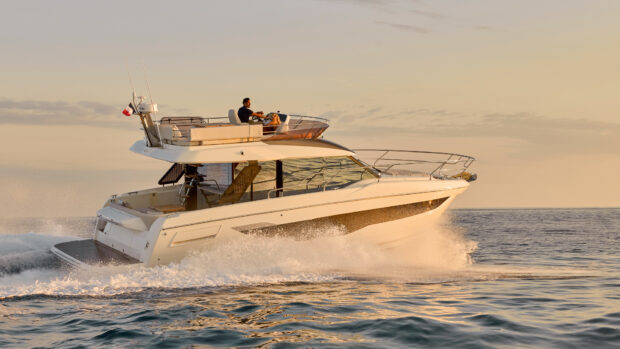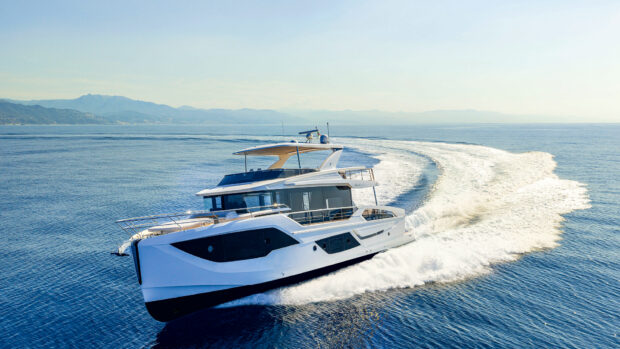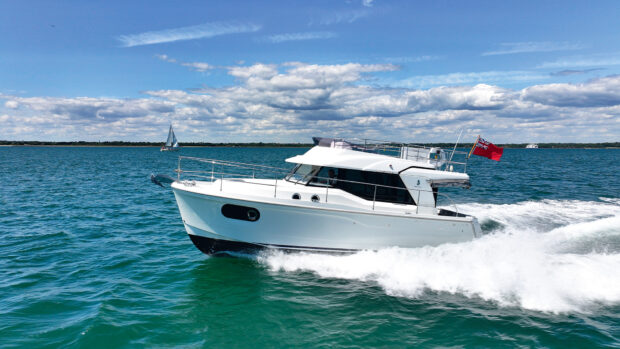Can the Antares 12 cope with its role as Beneteau’s flagship multi-function family cruiser? We head for Barcelona to find out…
While the world’s new boat prices have reached unprecedented heights over the last five years, the Beneteau Group has been working hard to build boats that still provide authentic value for money. The Flyer, Gran Turismo and Swift Trawler lines all look well priced in their respective sectors but in terms of reward for your investment, it’s the catch-all versatility of Beneteau’s Antares line that really hits the mark.
Here, in a fleet that comprises six hull lengths from six to 13m, the emphasis is squarely upon how much your boat can do for you – and the approach it takes to that is consistent throughout the line.
It’s about outboard-powered platforms with a variety of external day boating options and generous internal volume. It’s about using that volume to maximum effect courtesy of intelligent convertible layouts; and it’s about delivering all of these things in an easy-to-use family package at an affordable price.
It’s no easy task but having seen how much Beneteau can do at around the 26ft mark, our expectations for this new flagship 42-footer are unashamedly lofty.
But before we go any further, let’s address the elephant in the room. The Beneteau Antares 12 feels similar in a lot of ways to the excellent Jeanneau Merry Fisher 1295, which is also of course owned by the Beneteau Group.

The dinette faces across to a long port-side galley with a pop-up TV behind the hob, in exactly the position you would want it. Photo: Bertrand Duquenne Photography
This boat, like that one, is a three-cabin, flybridge-equipped, outboard-powered family cruiser designed to offer maximum breadth of application at the 40-43ft mark for around £500,000.
The Beneteau Antares 12 is in fact a foot and a half longer than the Merry Fisher but it’s interesting to note that it possesses a slightly sleeker, less upright profile and that fully backs up Beneteau’s contention that they are happy to sacrifice a little bit of functionality in pursuit of a more diverting aesthetic.
When you embark at the aft end, that is again borne out. While the 1295 uses a sliding aft bench to take advantage of the space above the engine well, the aft bench here is fixed. That enables the use of larger swim platforms linked by a hinged transverse bridge ahead of the outboards for easy movement from side-to-side.
And it also means that the back end on this boat comprises a moulded unit rather than a fabric backrest, increasing the cleanliness of the style and giving you a natural place to emblazon your boat name.

The foredeck sunbed features an integrated forward-facing couch so you can tuck yourself away from the primary day spaces at the cockpit and flybridge. Photo: Bertrand Duquenne Photography
Day boating differences
In terms of the main deck arrangement, the two boats again share similarities – most notably in the form of a moveable flybridge ladder, a drop-down starboard terrace and a wheelhouse structure that is offset to port, narrowing the port side deck in favour of increased saloon space. But the nature of the integration between that internal saloon and the external cockpit differs markedly.
While the 1295 uses an aft galley with a fold-out bar, what we have on the Beneteau Antares 12 is a big port dinette with a reversible aft backrest so you can take a seat and face your friends across the table on the big L-shaped cockpit bench.
At the forward end, there’s also a raised two-person co-pilot seat on the port side that drops down to dinette level when you reverse the backrest so you can take full advantage of the space and sit up to eight people in comfort.
With a drop-down table and infill, it’s no problem turning this space into an occasional guest double but at only 1.2m wide (a shade under 4ft), it’s arguably better suited to a pair of kids than an adult couple.

The wet bar sits behind a skipper’s chair that feels distinctly sociable, thanks to a pair of adjacent companion seats. Photo: Bertrand Duquenne Photography
Inevitably, this design decision pushes the galley across to the starboard side, where it occupies the entire length between the aft patio doors and the base for the skipper’s chair. On the test Beneteau Antares 12, you get a Whirlpool oven and two-ring induction hob, plus a pair of big Vitrifrigo fridges, with doors kept neatly in check by rough-sea retainers.
Rather cleverly, the crockery and glasses are stowed beneath the co-pilot dashtop where you might more commonly expect a chart or a TV – and that means that the pop-up TV is relocated to the galley, enabling it to face naturally across to the dinette beneath the shelter of the raised cupboards.
The single-level deck also feels good. It runs all the way from the transom to the helm, making the cockpit and saloon feel like an attractively unbroken space, and there’s plenty of under-deck storage too.
Article continues below…

Best 40ft flybridges: Our pick of the secondhand market

Jeanneau Merry Fisher 1295 sea trial review: On board the best £500k flybridge you can buy
In addition to a generous locker at the aft end of the saloon, there’s a compartment beneath the cockpit sole, big enough to accommodate the Seakeeper, the generator and the liferaft, with plenty of extra volume for canvas covers and bulky cruising baggage.
The hatch for that does get obstructed by the flybridge ladder, but you can unscrew the ladder from the deck and shift it up against the pilothouse structure to remedy this and to open up extra deck space for a large party.
Up at the bow, the Beneteau Antares 12 works the space equally hard. There’s a raised central island sunbed with angled headrests and integrated rails and cupholders. That’s big enough for three people and it remains so, even when you open up the forward-facing bench and turn the beamy forepeak into an intimate five-person lounge.

A roomy owner’s ensuite comes with a generous shower and plenty of extra storage. Photo: Bertrand Duquenne Photography
The side deck, which sweeps around from starboard to port, dips markedly at this point, enabling you to sit comfortably and securely with your feet down low in a very natural position. That said, the bow lounge does feel distinctly tight so if you want the freedom of some extra day space, the flybridge provides a very convincing solution.
It basically runs all the way to the transom and while that creates excellent shelter down in the cockpit, it also creates the space for an aft dinette, a convertible forward sun lounger and a compact starboard galley with space for an optional fridge and griddle.
Fantastic for four
The lower deck feels particularly rewarding because it knows exactly what it’s trying to achieve. Rather than spreading the joy evenly across the three cabins, the priority is placed squarely on the owner’s cabin and the port twin and that makes a big difference to your cruising comfort.
Up in the bow, the owner’s space provides loads of headroom for a six-footer, as well as plenty of light from the windows in the hull and the foredeck mouldings. Storage is well taken care of and if the scale of the central island bed is good, the scale of the starboard ensuite is even better. It occupies a really generous space with plenty of headroom, lots of light and a separate shower easily large enough for two people.

The large, well-lit owner’s cabin provides masses of headroom. Photo: Bertrand Duquenne Photography
Over on the port side, the guest twin can be converted into a queen-sized double with a simple infill, but with its lofty headroom, big windows and plentiful storage, it’s also a place you might happily visit for a bit of privacy during the day.
Better still, it also has its own door directly into the port day heads, so if you want to cruise as a pair of couples, it serves brilliantly well for that.
As you would expect then, the starboard guest cabin takes the hit for the loveliness elsewhere. In addition to the fact that it inhabits a narrower space, it uses a lower deckhead beneath the storage spaces for that starboard galley.

The larger port guest cabin gets masses of headroom and direct access to the day heads for ‘ensuite’ cruising. Photo: Bertrand Duquenne Photography
There’s still enough room to sit with a book or to change your clothes and there’s still the capacity to turn the single bed into a small double by folding out the hinged wooden base and using the backrest as an infill.
But although it could genuinely sleep a couple of adults, this starboard space is likely to find itself most commonly utilised as a handy back-up cabin for storage or kids.
Surfing the swells
It’s funny how impressions can change when you take a boat away from the serenity of the pontoon and head on out to sea – and in this case, the changes are largely positive. For instance, when you’re sitting alongside, visibility from the main deck’s elevated helm looks particularly restricted past that stooping forward roofline.
But once you get underway and the running attitude alters your perspective, the combination of a raised bow and a sloping foredeck helps open the views right up. In fact, visibility is really good, especially with the skipper’s side door open – and once you close up the various doors and windows, it’s remarkably refined too.

Though smaller and lower, the starboard cabin’s convertible settee makes a handy day retreat and a useful extra berth. Photo: Bertrand Duquenne Photography
At cruising speeds in the low 20s, our sound readings hover at around 71dB, which is remarkably user-friendly for long cruises.
On our test day, there are lots of four-footers rolling around and while that’s not this boat’s natural element, it actually does a very convincing job.
True, as we turn into a big head sea, we have little choice but to come off the power and pick our moment because that fulsome bow has the capacity to turn even a molehill into a mountain if suitably provoked. But once we’ve negotiated our 180 and swept the screen clear of spray, this boat runs along the troughs a treat.
As we throttle on between 4ft peaks at 22 to 24 knots, the swells roll through with very little in the way of impact, instability or water ingress – and when we turn back toward the land with the swells on our stern, the behaviour of the Beneteau Antares 12 is even more impressive.

You can perch the stern on a crest and feather the throttle, riding big swells toward the shore with remarkable ease. Photo: Bertrand Duquenne Photography
A combination of a steady low-speed plane, an elevated nose and entirely reliable grip at the props, even with those legs substantially elevated, enables you to surf the seas with remarkable ease.
We’re able to feather the throttle and perch the stern on a crest, riding big swells toward the shore with no concerns at all. At no point do we threaten to fall off the back of a swell, to bury the nose or to trip on a wave shape and steer by the bow.
On the contrary, this is one of the most settled, stable and confidence-inspiring following sea boats you’re likely to witness.
In terms of engines, you could swap the triple 300s for a pair of Mercury 400hp 5.7L V10s and that would certainly shave a few quid off the purchase price, but according to Beneteau, it’s not a worthwhile trade.

Photo: Bertrand Duquenne Photography
On this boat, the 400s will apparently delay the planing time by four seconds, reduce the top end by four knots and increase cruising fuel flow by 5 to 10%. As things stand, our fuel flow hovers at 7.0 to 7.5 litres per nautical mile at everything from 17 to 33 knots for a range of between 120 and 135 miles.
That’s not especially frugal by any means but given that this is a 9.1-tonne boat with triple big-block V8 outboards, it remains a broadly acceptable return.
Beneteau Antares 12 specifications
LOA: 42ft 7in (12.97m)
Beam: 12ft 5in (3.78m)
Draft:: 3ft 10in (1.10m)
Displacement: 9,111 kg
Fuel capacity: 1,174 litres
Engines: Triple 300hp 4.6L V8 outboard engines
RCD: B10/C12
Beneteau Antares 12 costs & options
Price from: €415,000 ex VAT
Test boat includes the following options:
Zipwake auto trim tabs: €2,600
Seakeeper SK3 stabilisation: €57,600
Mase VS8.5 8kW generator: €23,920
Flybridge kitchen: €4,500
Cockpit curtains: €2,780
Foredeck sunshade: €3,680
Verdict
Those of you who have been out on an Antares will know just how much more they tend to offer than their size or pricing implies – and the same is true of the Antares 12. It has three independent open-air day boating zones, it has the capacity to sleep up to eight people at a time and it has a large internal dinette for sheltered parties when the weather turns. If you like to cruise as two couples, both the headroom and the ensuite facilities of the forward and port cabins are also likely to appeal. But the competition (by which we mean the Jeanneau Merry Fisher 1295) remains extremely strong... In spite of the Jeanneau’s shorter length, it features a larger and more versatile saloon, plus a better appointed galley with inside-outside bar. At about a tonne lighter, five knots faster and two litres per mile more efficient, it also offers a helming experience that is more economical, as well as more responsive. For us then, the Jeanneau Merry Fisher 1295, which scooped a Highly Commended at the 2023 MBY Awards, remains the market’s most convincing 40ft family flybridge cruiser. But if you’re in the market for a boat that majors on both volume and day boating flexibility and yet still manages to look good and undercut the bulk of the competition in terms of price, this new flagship Antares is undoubtedly a boat you need to see.










